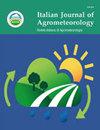Agronomical management of detention basin
IF 0.8
4区 农林科学
Q2 AGRONOMY
Italian Journal of Agrometeorology-Rivista Italiana Di Agrometeorologia
Pub Date : 2023-08-03
DOI:10.36253/ijam-2239
引用次数: 0
Abstract
The importance of effective stormwater management through detention basin arrangement has become increasingly evident due to recurring extreme events in recent years. Limitations of the traditional detention basin include a reduced ability of basins to infiltrate water due to compacted soil and the carbon cost associated with the Diesel-powered tractors with lawn shredders. This study aims to compare six different agronomical management approaches for detention basins to improve the water storage capacity and the carbon sequestration potential, including the cultivation of crimson clover, white clover, tillage radish, and two mono-dicotyledonous mixes, against the conventional stable lawn-based approach. The trial was conducted in the detention basin in Castelletti (Firenze, Italy) for one growing season (2020/2021) according to a randomized complete block design with 9 replicates. Soil physical and chemical properties, as well as soil water storage capacity, were assessed to determine the feasibility of agronomical management for detention basins. Results indicated that the different treatments significantly influenced aboveground biomass production, soil organic carbon (SOC) stock, carbon sequestration potential, and water storage capacity. Specifically, crimson clover exhibited the highest aboveground biomass of around 6 t ha-1 among the treatments, while tillage radish demonstrated the greatest carbon sequestration potential (4.58 t CO2 ha-1), stable carbon stock in soil (1.14 t S-SOC ha-1), as well as the highest potential for improving the water storage volume (389 m3 ha-1) in the topsoil (0-20 cm) of the detention basin. The findings suggested also that the sowing of different mono-dicotyledonous plant mix were poorly effective in improving carbon sequestration potential and water storage volume compared to conventional basin management. To sum up, this experiment has demonstrated that alternative agronomical management practices can enhance the capacity of detention basins to store carbon and stormwater. These results provide valuable insights for improving the sustainability and functionality of detention basins.滞留盆地的农艺学管理
近年来,由于极端天气事件的不断发生,通过蓄洪区安排进行有效雨水管理的重要性日益凸显。传统截留池的局限性包括:由于土壤压实,截留池渗透水的能力降低,以及与带有草坪碎纸机的柴油动力拖拉机相关的碳成本。本研究旨在比较六种不同的滞留盆地农学管理方法,包括种植深红色三叶草、白三叶草、耕作萝卜和两种单双子叶植物混合,以提高储水能力和固碳潜力,与传统的以稳定草坪为基础的方法进行比较。试验在Castelletti(意大利佛罗伦萨)的滞留盆地进行,为期一个生长季节(2020/2021),采用随机完全区组设计,共有9个重复。评估了土壤的物理和化学性质以及土壤储水能力,以确定对滞留盆地进行农艺管理的可行性。结果表明,不同处理对地上生物量、土壤有机碳储量、固碳潜力和储水能力均有显著影响。其中,深红三叶草的地上生物量最高,约为6 t ha-1,而耕作萝卜具有最大的固碳潜力(4.58 t CO2 -1),土壤稳定碳储量(1.14 t S-SOC ha-1),并具有最大的提高蓄水容量(389 m3 ha-1)的潜力(0-20 cm)。研究结果还表明,与传统的流域管理相比,不同单双子叶植物组合播种在提高固碳潜力和储水量方面效果较差。综上所述,本试验表明,替代的农艺管理措施可以提高滞流流域储存碳和雨水的能力。这些结果为提高滞留盆地的可持续性和功能性提供了有价值的见解。
本文章由计算机程序翻译,如有差异,请以英文原文为准。
求助全文
约1分钟内获得全文
求助全文
来源期刊

Italian Journal of Agrometeorology-Rivista Italiana Di Agrometeorologia
AGRONOMY-ENVIRONMENTAL SCIENCES
CiteScore
2.10
自引率
8.30%
发文量
6
期刊介绍:
Among the areas of specific interest of the journal there are: ecophysiology; phenology; plant growth, quality and quantity of production; plant pathology; entomology; welfare conditions of livestocks; soil physics and hydrology; micrometeorology; modeling, simulation and forecasting; remote sensing; territorial planning; geographical information systems and spatialization techniques; instrumentation to measure physical and biological quantities; data validation techniques, agroclimatology; agriculture scientific dissemination; support services for farmers.
 求助内容:
求助内容: 应助结果提醒方式:
应助结果提醒方式:


